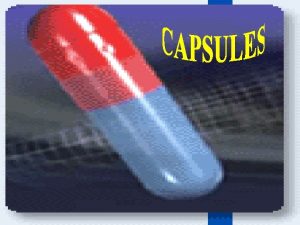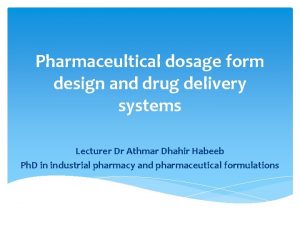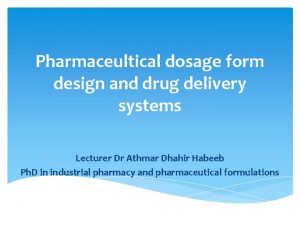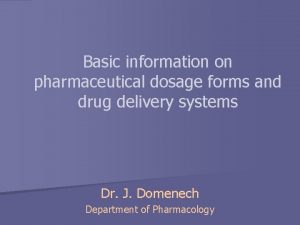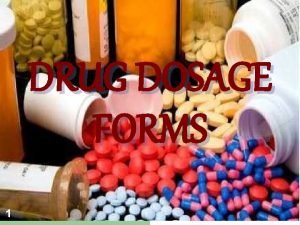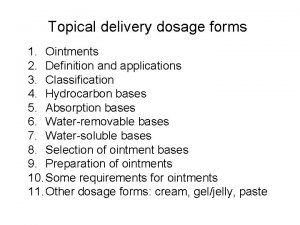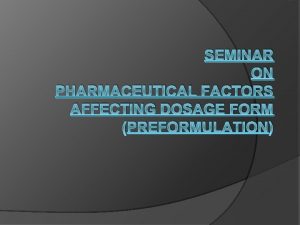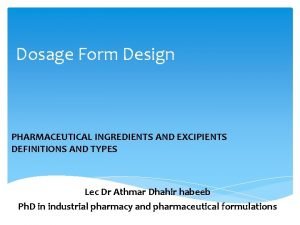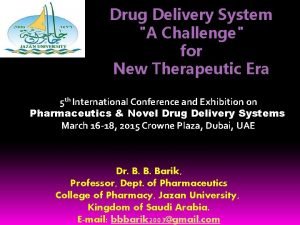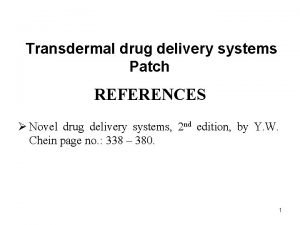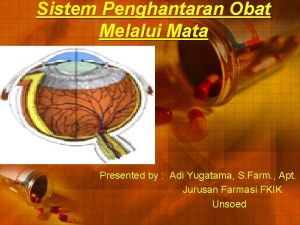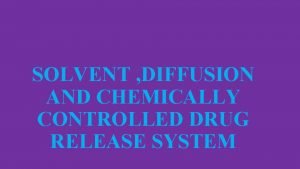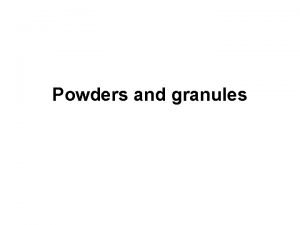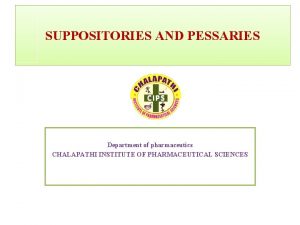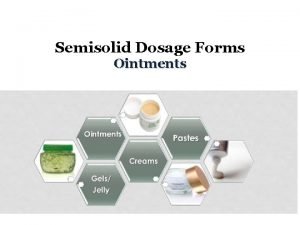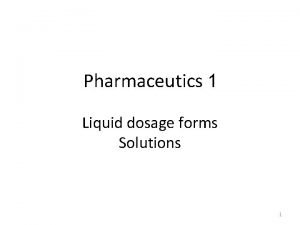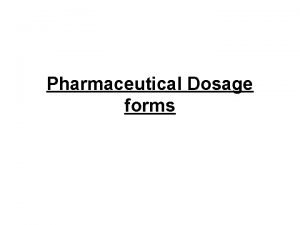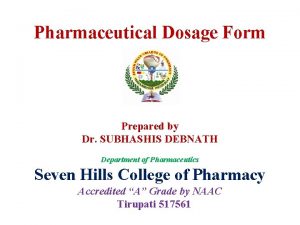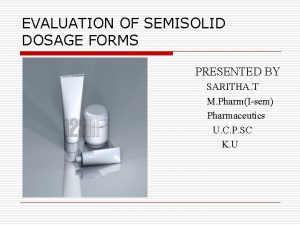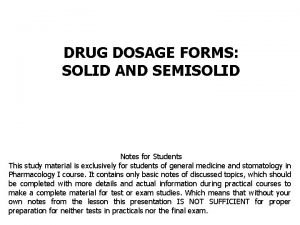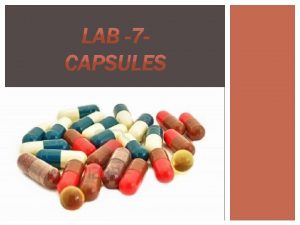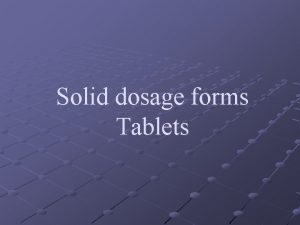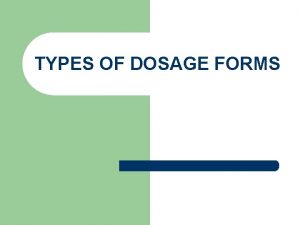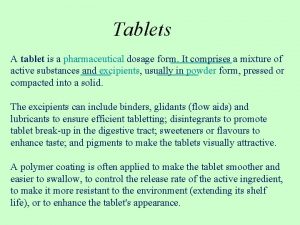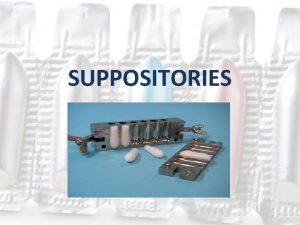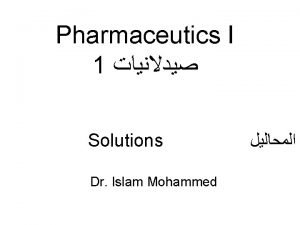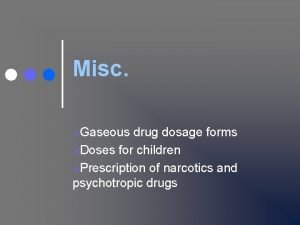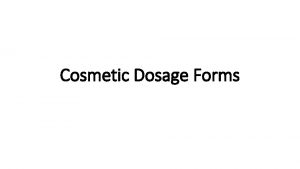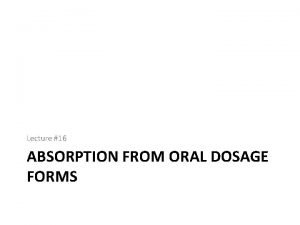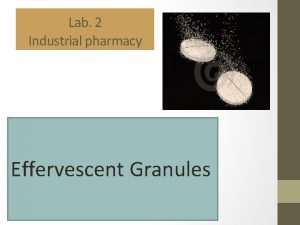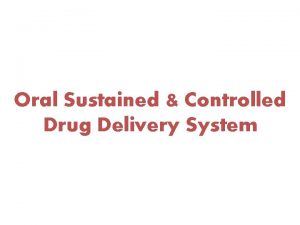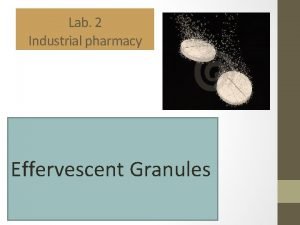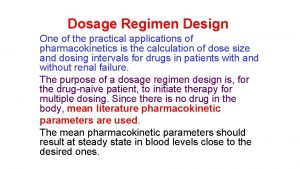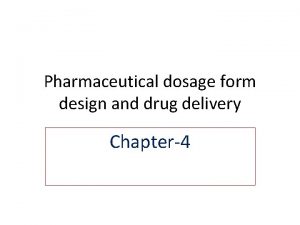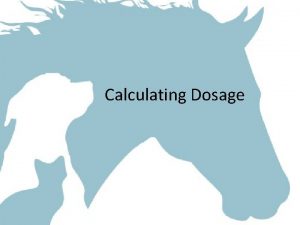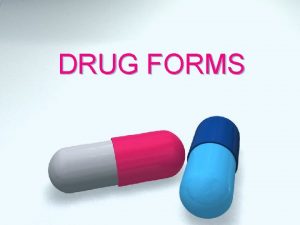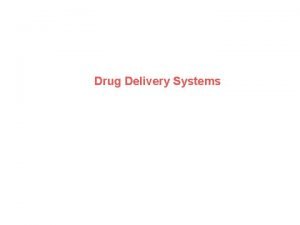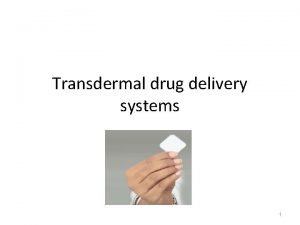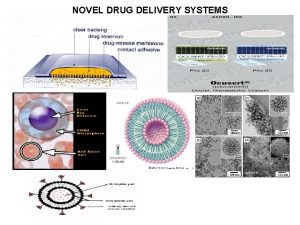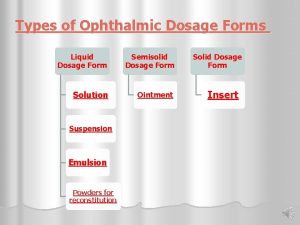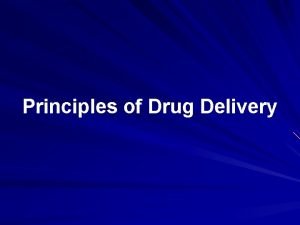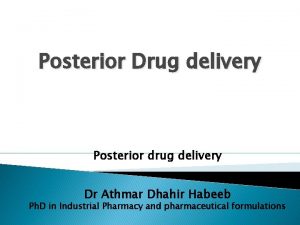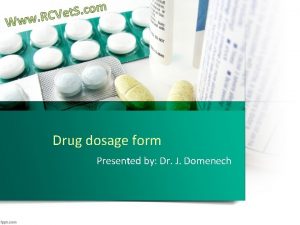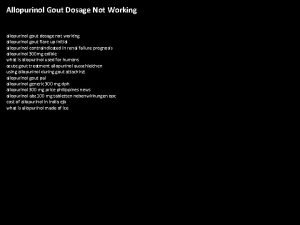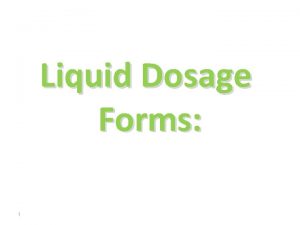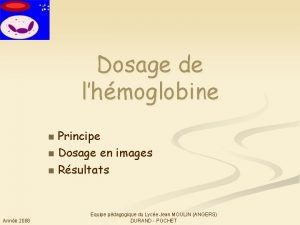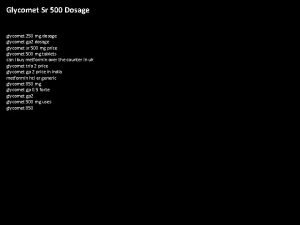Pharmaceultical dosage form design and drug delivery systems


![�Poorly-soluble weakly-acidic drugs: p. H = p. Ka + log [(St - So)/So] (2) �Poorly-soluble weakly-acidic drugs: p. H = p. Ka + log [(St - So)/So] (2)](https://slidetodoc.com/presentation_image/451f2f80ad602d526e7da937d1907cbc/image-3.jpg)











































- Slides: 46

Pharmaceultical dosage form design and drug delivery systems Lecturer Dr Athmar Dhahir Habeeb Ph. D in industrial pharmacy and pharmaceutical formulations

Log aqueous solubility (mmol) p. H-Solubility Profile 5 Indomethacin (weak acid) 4 3 Chlorpromazine (weak base) 2 1 Oxytetracycline (amphoteric) 2 4 6 8 10 p. H 12 14
![Poorlysoluble weaklyacidic drugs p H p Ka log St SoSo 2 �Poorly-soluble weakly-acidic drugs: p. H = p. Ka + log [(St - So)/So] (2)](https://slidetodoc.com/presentation_image/451f2f80ad602d526e7da937d1907cbc/image-3.jpg)
�Poorly-soluble weakly-acidic drugs: p. H = p. Ka + log [(St - So)/So] (2) �Poorly-soluble weakly-basic drugs: p. H = p. Ka + log [So/(St - So)] (3) where So = solubility of unionized free acid or base St = total solubility (unionized + ionized)

Dissolution dissolution rate, or time it takes for the drug to dissolve in the fluids at the absorption site, is the rate-limiting step in absorption. when the dissolution rate is the rate-limiting step, anything that affects it will also affect absorption. the dissolution rate of drugs may be increased by decreasing the drug’s particle size. it may also be increased by increasing its solubility in diffusion layer Means of enhancing the slow dissolution: 1. Particle size reduction (most commonly used). 2. Enhanced surface area by adsorbing the drug on an inert excipient with a high surface area, i. e. , fumed silicon dioxide. 3. Co-melting, co-precipitating, or triturating the drug with some excipients. 4. Incorporation of suitable surfactant. 5. the most effective means of obtaining higher dissolution rates is to use a highly-water soluble salt of the parent substance

Dissolution rates of chemical compounds are determined by 2 methods: 1. Constant-surface method - which intrinsic dissolution rate of the agent. provides the 2. Particulate dissolution - in which a suspension of the agent is added to a fixed amountofsolventwithoutexactcontrolof surface area. Constant-surface method uses a compressed disc of known area. This method eliminates surface area and surface electrical charges as dissolution variables. The dissolution rate obtained by this method, the intrinsic dissolution rate, is characteristics of each solid compound a given solvent in the fixed experimental conditions. The value is expressed in milligrams dissolved per minute per centimeters squared. It has been suggested that this value is useful in predicting probable absorption problems due to dissolution rate.

Particulate dissolution a weighed amount of powdered sample is added to the dissolution medium in a constant agitation system. This method is used to study the influence of particle size, surface area, and excipients upon the active agent. Fick’s Laws describe the relationship of diffusion and dissolution of the active drug in the dosage form and when administered in the body. Early formulation studies should include the effects of pharmaceutical ingredients on the dissolution characteristics of the drug substance.

Membrane Permeability To produce a biologic response, the drug molecule must first cross a biologic membrane. The biologic membrane acts as a lipid barrier to most drugs and permits the absorption of lipid-soluble substances by passive diffusion, while lipid insoluble substances can diffuse across the barrier only with considerable difficulty if at all. Everted intestinal sac may be used to evaluate absorption characteristics of drug substances. A piece of intestine is removed from an intact animal, everted, filled with a solution of the drugs substance, and the degree and rate of passage of the drug through membrane sac is determined. This method allows evaluation of both passive and active transport.

Partition Coefficient Inherent in this procedure is the selection of appropriate extraction solvents, drug stability, use of salting-out additives, and environmental concerns. the octanol water partition coefficient is commonly used in formulation development P = (Conc. Of drug in octanol) / (Conc. Of drug in water) P depends on the drug concentration only if the drug molecules have tendency to associate in solution. For an ionizable drug, the following equation is applicable: P = (Conc. Of drug in octanol) / [1 -α] (Conc. Of drug in water) Where α equals the degree of ionization

pka / Dissociation constants Importance of dissociation or ionization constant of drug substances. Ø The extent of ionization has an effect on formulation and pharmacokinetics parameters of the drug. Ø In many cases it is dependent on the p. H of the medium containing the drug. Ø Formulation p. H provide a certain level of ionization of the drug for solubility and stability. In pharmacokinetic area Ø the extent of ionization of a drug has a strong effect on its extent of absorption, distribution, and elimination. For the practicing pharmacist, it is important in predicting precipitation in admixtures and in calculating the solubility of drugs at certain p. H values.

Drug and drug product stability One of the most important activities of preformulation work is evaluation of the physical and chemical stability of the pure drug substance. It is essential that these initial studies be conducted using drug samples of known purity. The presence of impurities can lead to erroneous conclusions in such evaluations. Stability studies in preformulation phase include 1. Solid-state stability of the drug alone 2. Solution phase stability 3. Stability in presence of expected excipients. Initial investigation begins with knowledge of the drug’s chemical structure, which allows the preformulation scientist to anticipate the possible degradation reactions.

Drug stability: Mechanism of Degradation Chemical instability of medicinal agents may take many forms because the drugs in use today are of such diverse chemical constitution. Chemically, drug substances are alcohols, phenols, aldehydes, ketones, esters ethers, acids, salts, alkaloids, glycosides, and others, each with reactive chemical groups having different susceptibilities to chemical instability. Oxidation Main Degradation pathways Hydrolysis

Hydrolysis is a solvolysis process in which (drug) molecules interact with water molecules to yield breakdown products. For example, aspirin, or acetylsalicylic acid, combines with a water molecule Hydrolysis is probably the most important single cause of drug decomposition, mainly because a great number of medicinal agent are esters or contain such other groupings as substituted amides, lactones, and lactams, which are susceptible to the hydrolytic process

Oxidation Another destructive process is oxidation, which destroys many drug types, including aldehydes, alcohols, phenols, sugars, alkaloids, and unsaturated fats and oils. Oxidation frequently involves free chemical radicals Many of the oxidative change in pharmaceutical preparation have a character of autoxidations. Autoxidations occur spontaneously under initial influence of atmospheric oxygen and proceed slowly at first and then more rapidly.

The process has been described as a type of chain reaction commencing with the union of oxygen with the drug molecule and continuing with a free radical of this oxidized molecule participating in the destruction of other drug molecules and so forth. In drug product formulation work, steps are taken to reduce or prevent deterioration due to hydrolysis, oxidation, and other processes.

Drug and product stability: kinetics and shelf life Stability is the extent to which a product retains within specified limits and throughout its period of storage and use (i. e. , its shelf life) the same properties and characteristics that it possessed at the time of its manufacture. Five types of stability concern pharmacists: 1. Chemical: . 2. Physical: . 3. Microbiologic: . 4. Therapeutic: . 5. Toxicologic: .

1. Chemical: Each active ingredient retains its chemical integrity and labeled potency within the specified limits. 2. Physical: The original physical properties, including appearance, palatability, uniformity, dissolution, and suspendability, are retained. 3. Microbiologic: Sterility or resistance to microbial growth is retained according tothe specified requirements. Antimicrobial agents retain effectiveness within specified limits. 4. Therapeutic: The therapeutic effect remains unchanged. 5. Toxicologic: No significant increase in toxicity occurs.

Chemical stability is important for 1. selecting storage conditions (Temperature, light , humidity) 2. selecting the proper container for dispensing 3. anticipating interactions when mixing drugs and dosage forms. Stability and expiration dating are based on reaction kinetics It is the study of the rate of chemical change and the way this rate is influenced by concentration of reactants, products, and other chemical species and by factors such as solvent, pressure, and temperature.

In considering chemical stability of a pharmaceutical, one must know the reaction order and reaction rate. The reaction order may be the overall order (the sum of the exponents of the concentration terms of the rate expression), or the order with respect to each reactant (the exponent of the individual concentration term in the rate expression). The reaction rate is a description of the drug concentration with respect to time. Most commonly, zero-order and first-order reactions are encountered in pharmacy.

Q 10 Method of Shelf Life Estimation The Q 10 method of shelf life estimation lets the pharmacist estimate shelf life for a product that has been stored or is going to be stored under a different set of conditions.




Enhancing Stability of Drug Products Many pharmaceutical ingredients may be used to prepare the desired dosage form of a drug substances may be used to increase the stability of the drug substance, particularly against hydrolysis and oxidation. In each instance, the added pharmaceutical ingredient must be compatible with and must not detract from the stability of the drug substance.

There are several approaches to the stabilization of pharmaceutical preparations containing drugs subject to hydrolysis. Perhaps the most obvious is the reduction or elimination of water from the pharmaceutical system. solid dosage forms containing water-labile drugs must be protected from humidity in the atmosphere. In liquid preparations water reduced or replaced through the use of substitute liquid such as glycerin PG and alcohol. In certain injectable products, anhydrous vegetable oils may be used as the drug’s solvent to reduce hydrolytic decomposition

in other liquid drugs by suspending them in a nonaqueous vehicle rather than dissolving them in an aqueous solvent. unstable antibiotic the drug may be supplied to the pharmacist in a dry form for reconstitution by adding a specified volume of purified water just before dispensing. The dry powder is actually a mixture of the antibiotic, suspending agents, flavorants, and colorants; when reconstituted by the pharmacist, it remains stable for the period over which the preparation is normally consumed. Refrigeration is advisable for most preparations considered subject to hydrolysis. Together with temperature, p. H is a major determinant of the stability of a drug prone to hydrolytic decomposition. Hydrolysis of most drugs depends on the relative concentrations of the hydroxyl and hydronium ions, and a p. H at which each drug is optimally stable can be easily determined. For most hydrolysable drugs, optimum stability is on the acid side, somewhere between p. H 5 and 6. Therefore, through judicious use of buffering agents, the stability of otherwise unstable compounds can be increased. Buffers are used to maintain a certain p. H

oxidation Pharmaceutically, oxidation of a susceptible drug substance is most likely to occur when 1. it is not kept dry in the presence of oxygen 2. it is exposed to light 3. combined with other chemical agents without proper regard to their influence on oxidation. Oxidation of a chemical in pharmaceutical preparation is usually accompanied by 1. an alteration in the color of that preparation. 2. It may also result in precipitation 3. a change in odor.

The oxidative process is diverted and the stability of the drug is preserved by agents called antioxidants which react with one or more compounds in the drug to prevent progress of the chain reaction. In general, antioxidants act by providing electrons and easily available hydrogen atoms that are accepted more readily by the free radicals than are those of the drug being protected. Various antioxidants are employed in pharmacy. 1 - Among those most frequently used in aqueous preparations are sodium sulfite (Na 2 SO 3 at high p. H values), sodium bisulfite (Na. HSO 3 at intermediate p. H values), sodium metabisulfite (Na 2 S 2 O 5 at low p. H values), hypophosphorous acid (H 3 PO 2), and ascorbic acid. 2 - In oleaginous (oily or unctuous) preparations, alpha-tocopherol, butyl hydroxy anisole, and ascorbyl palmitate find application.

In June 1987, U. S. FDA labeling regulations went into effect requiring a warning about possible allergic-type reactions, including anaphylaxis, in the package insert for prescription drugs to whose final dosage form sulfites have been added. Some but not all epinephrine injections contain sulfites The proper use of antioxidants permits their specific application only after appropriate biomedical and pharmaceutical studies. In certain instances, other pharmaceutical additives can inactivate a given antioxidant. In other cases, certain antioxidants can react chemically with the drugs they were intended to stabilize without a noticeable change in the appearance of the preparation.

Because oxygen may adversely affect their stability, certain pharmaceuticals require an oxygen-free atmosphere during preparation and storage. Oxygen may be present in pharmaceutical liquids in the airspace within the container or may be dissolved in the liquid vehicle. To avoid these exposures, oxygen-sensitive drugs may be prepared in the dry state and packaged in sealed containers With the air replaced by an inert gas such as nitrogen, as may liquid preparations. This is a common practice in commercial production of vials and ampuls of easily oxidizable preparations intended for parenteral use

Trace metals originating in the drug, solvent, container, or stopper are a constant source of difficulty in preparing stable solutions of oxidizable drugs. The rate of formation of color in epinephrine solutions, for instance, is greatly increased by the presence of ferric, ferrous, cupric, and chromic ions. Great care must be taken to eliminate these trace metals from labile preparations by 1. thorough purification of the source of the contaminant 2. by chemically complexing or binding the metal through the use of specialized agents that make it chemically unavailable for participation in the oxidative process (EDTA and calcium di sodium edetate).

Light can also act as a catalyst to oxidation reactionstransferring its energy (photons) to drug molecules, making the latter more reactive through increased energy capability. As a precaution against acceleration of oxidation, sensitive preparations are packaged in light-resistant or opaque containers. Because most drug degradations proceed more rapidly as temperature increases, it is also advisable to maintain oxidizable drugs in a cool place. Another factor that can affect the stability of an oxidizable drug in solution is the p. H of the preparation. Each drug must be maintained in solution at the p. H most favorable to its stability. In some instances, the specific agent to employ as a stabilizer is mentioned in the monograph, and in others the term “suitable stabilizer” is used.

Polymerization, chemical decarboxylation, and deamination Destructive processes Polymerization is a reaction between two or more identical molecules that forms a new and generally larger molecule. Formaldehyde In solution it may polymerize to paraformaldehyde (CH 2 O)n The official formaldehyde solution contains approximately 37% formaldehyde and according to the USP, should be stored at temperatures not below 15°C (59°F).

Other organic drug molecules may be degraded through processes in which one or more of their active chemical groups are removed. Decarboxylation, and deamination are examples of such processes For example, insulin, a protein. most preparations of insulin are neutralized to reduce the rate of decomposition.

Stability Teting Drug and drug product stability testing during every stage of development is critical to the quality of the product. 1. Drug stability is important during preclinical testing and in clinical (human) trials to obtain a true and accurate assessment of the product being evaluated. 2. For a marketed drug product, assurance of stability is vital to its safety and effectiveness during the course of its shelf life and use

The FDA-required demonstration of drug stability is necessarily different for each stage of drug development, EX: for a 2 -week preclinical study, an early Phase I study, a limited Phase II trial, a pivotal Phase III clinical study, for a new drug application.

Before approval for marketing, a product’s stability must be assessed with regard to its formulation; 1. the influence of its pharmaceutical ingredients; 2. the influence of the container and closure; 3. the manufacturing and processing conditions (e. g. , heat); 4. packaging components; 5. conditions of storage; 6. anticipated conditions of shipping, temperature, light, and humidity; and 7. anticipated duration and conditions of pharmacy shelf life and patient use. Holding intermediate product components (such as drug granulations for tablets) for long periods before processing into finished pharmaceutical products can affect the stability of both the intermediate component and the finished product. Therefore, in-process stability testing, including retesting of intermediate components, is important.

Product containers, closures, and other packaging features must be considered in stability testing. Sterile products must meet sterility test standards to ensure protection against microbial contamination. All preservatives must be tested for effectiveness in the finished product. How to detect product instability Physical appearancecolor, odor, taste, or texture of the formulation, Chemical changes(chemical changes may not be self-evident and may be ascertained only through chemical analysis)

Obviously, the rate at which a drug product degrades is of prime importance. The study of the rate of chemical change and the way it is influenced by such factors as the concentration of the drug or reactant, the solvent, temperature and pressure, and other chemical agents in the formulation is reaction kinetics. In general, a kinetic study begins by measuring the concentration of the drug at given intervals under a specific set of conditionsincluding temperature, p. H, ionic strength, light intensity, and drug concentration. The measurement of the drug’s concentration at the various times reveals the stability or instability of the drug under the specified conditions with the passage of time. From this starting point, each of the original conditions may be varied to determine the influence of such changes on the drug’s stability.

From the experimental data, the reaction rate may be determined and a rate constant and half-life calculated. Accelerated testing: Studies designed to increase the rate of chemical degradation or physical change of a drug substance or drug product by using exaggerated storage conditions as part of longterm, intermediate, and accelerated studies. Data from these studies are used to assess degradation that might occur under normal (nonexaggerated) or slight deviations in storage conditions as during shipping and storage. Results allow the development of product labeling with regard to expiration dating and recommended conditions for storage. The use of exaggerated conditions of temperature, humidity, light, and others to test the stability of drug formulations is termed accelerated stability testing. conducted for 6 months at 40°C with 75% relative humidity. If a significant change in the product occurs Short-term accelerated studies are used to determine the most stable of

In addition to the accelerated stability studies, drug products are subjected to long-term stability studies under the usual conditions of transport and storage expected during product distribution. Geographic regions are defined by zones: zone I, temperate; zone II, subtropical; zone III, hot and dry; and zone IV, hot and humid. In general, however, the long-term (12 months minimum) testing of new drug entities is conducted at 25°C ± 2°C and at a relative humidity of 60% ± 5%.

Samples maintained under these conditions may be retained for 5 years or longer These studies, considered with the accelerated stability studies previously performed, lead to a more precise determination of drug product stability, actual shelf life, and the possible extension of expiration dating.

In addition, signs of degradation of the specific dosage forms must be observed and reported. For the various dosage forms, this includes the following (1): Tablets: Capsules: Oral solutions and suspensions: Oral powders: Metered-dose inhalation aerosols: Topical nonmetered aerosols: Topical creams, ointments, lotions, solutions, and gels

Ophthalmic and nasal and oral inhalation preparations: Small-volume parenterals: Large-volume parenterals: Suppositories: Emulsions: Controlled-release membrane drug delivery systems:

Under usual circumstances, most manufactured products must have a shelf life of 2 or more years to ensure stability at the time of consumption. Commercial products must bear an appropriate expiration date that sets out the time during which the product may be expected to maintain its potency and remain stable under the designated storage conditions. The expiration date limits the time during which the product may be dispensed by the pharmacist or used by the patient.

Prescriptions requiring extemporaneous compounding by the pharmacist do not require the extended shelf life that commercially manufactured and distributed products do because they are intended to be used immediately on receipt by the patient and used only during the immediate course of the prescribed treatment. However, these compounded prescriptions must remain stable and efficacious during the course of use, and the compounding pharmacist must employ formulative components and techniques that will result in a stable product

Reference Ansel’s pharmaceutical dosage forms and drug delivery systems , tenth edition
 Filling of hard gelatin capsules slideshare
Filling of hard gelatin capsules slideshare Shelf life of drug
Shelf life of drug Dosage forms and drug delivery systems
Dosage forms and drug delivery systems Parenteral dosage form example
Parenteral dosage form example Name some of the modern dosage forms
Name some of the modern dosage forms Hydrocarbon ointment base
Hydrocarbon ointment base Individualization of drug dosage regimen
Individualization of drug dosage regimen Types of adulteration of crude drugs
Types of adulteration of crude drugs Dynamic angle of repose
Dynamic angle of repose Dosage form design definition
Dosage form design definition Dosage form design definition
Dosage form design definition Newer drug delivery system
Newer drug delivery system Transdermal drug delivery system
Transdermal drug delivery system Ocusert adalah
Ocusert adalah Reservoir system
Reservoir system Accenture delivery suite (ads support)
Accenture delivery suite (ads support) Granular powder examples
Granular powder examples Monophasic liquid are prepared with which solvent
Monophasic liquid are prepared with which solvent Input system design
Input system design Introduction to healthcare delivery systems
Introduction to healthcare delivery systems Social service delivery systems
Social service delivery systems Disadvantages of suppositories
Disadvantages of suppositories Suppository mold calibration
Suppository mold calibration Types of semi solid dosage form
Types of semi solid dosage form Medicated elixirs examples
Medicated elixirs examples Dosage form definition in pharmacy
Dosage form definition in pharmacy Classification of dosage forms pdf
Classification of dosage forms pdf Magmas dosage form
Magmas dosage form Semisolid dosage form definition
Semisolid dosage form definition Dosage form notes
Dosage form notes Advantages of capsule dosage form
Advantages of capsule dosage form Aerosols is pressurised dosage form
Aerosols is pressurised dosage form Advantages of semi solid dosage form
Advantages of semi solid dosage form Advantages of semi solid dosage form
Advantages of semi solid dosage form Types of dosage forms
Types of dosage forms Disintegration definition tablet
Disintegration definition tablet Suppositories definition in pharmacy
Suppositories definition in pharmacy Chlorhexidine gluconate solution 5
Chlorhexidine gluconate solution 5 Gaseous dosage forms
Gaseous dosage forms Simplest dosage form
Simplest dosage form Semisolid dosage form classification
Semisolid dosage form classification Dental cones tablets
Dental cones tablets Granule effervescent
Granule effervescent Advantages of solid dosage form
Advantages of solid dosage form Modified release dosage forms
Modified release dosage forms Granules pharmacy
Granules pharmacy Loading dose formula
Loading dose formula
